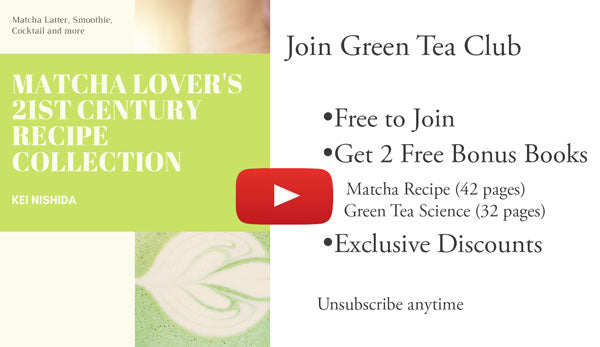In this video, Kei Nishida, CEO of Japanese Green Tea Co., explains what matcha is. Kei answers questions from an interviewer at the International Virtual Tea Festival 2020.
If you like this video, please click here to subscribe to our YouTube Channel so that you don't miss future videos from us.
Click to Subscribe to my YouTube Channel
Video Script:
- I'm not as familiar with the matcha green tea.
Can you tell me some more about it?
I know you have videos out there I could watch, but tell me a little bit about it.
- Yup, okay. Matcha tea. This is loose leaf green tea. I don't know if you can see, it's a tea leaf. Matcha looks like this and it's powder.
- Powdery, yes.
- The loose leaf you would be using teapot like this and steep it, right?
But matcha is powder, so you wouldn't use this.
People tend to use something like a whisk, and if you have a bowl and you would be whisking them with the hot water is the traditional way. But it's not only the powder or the loose-leaf that is the difference. If you powder this tea it doesn't become matcha.
That's called Konacha and it's just a powder tea, which is still good. But the difference between the matcha and this tea is, let me actually show you my screen. So this is a tea farm, our tea farm in Japan, right?
We pick these tea leaf. What we do with matcha is we cover the tea with this black tarp before harvesting. What this does is, it makes the tea hungry for the sunlight. It produces a lot of different chemicals, which includes caffeine and a lot of healthy chemicals included.
This is what it looks.
We keep the tea under the tarp for a specific period of time before harvesting. What it does is, this is what it looks like.
Right side is covered and the left side is the tea that is not covered. You see the difference in the color?

- Yeah.
- It becomes a lot brighter and a vibrant color, that's because of the covering. That's why matcha, if you see a good matcha, you will have a very bright color and the nice color. Bright color doesn't mean that the tea is good or bad because non-covered tea is also good.
There are a lot of good tea, just a covered tea will have a different color like this. So once we have this covered tea, after harvesting we steam them and we take out the vein of the tea leaf and we grind them with a stone. So by grinding with the stone, sorry, I don't have the picture here, it is much finer than, say, you would be doing from a coffee grinder type.
It's very, very fine because of the pressure that you get from the stone. The result of it is matcha.
- Hmm. I've seen people bake with it because it's like a powder and they use it for baking and coloring and the flavor. That's the first time I'd ever heard of matcha was watching people bake with it, so that's kind of interesting, yeah.
- Yup.
- Thank you.

Buy Matcha
Buy Matcha Whisk

Get Free Bonus Books

Sign up for free to the Green Tea Club to get advice and exclusive articles about how to choose Japanese Tea, and tips, tricks, and recipes for enjoying Japanese tea.
About the author
Kei Nishida
Author, CEO Dream of Japan
Certification: PMP, BS in Computer Science
Education: Western Washington University
Kei Nishida is a Japanese green tea enthusiast, a writer, and the founder and CEO of Japanese Green Tea Co., a Dream of Japan Company. His passion for introducing America to the tea of his homeland was the catalyst for creating the only company that brings high-quality tea from Arahataen Green Tea Farms to the rest of the world. Learn more about Kei






















